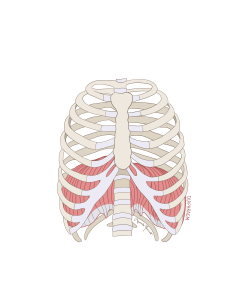53 Diaphragm
What is the diaphragm?
Did you know that the body has its own built-in pressure generating muscle? This muscle is known as the diaphragm and every time it contracts and relaxes, it allows air into and out of the lungs. Without the diaphragm, breathing would be like trying to inflate a tire with no pump.
The diaphragm is a dome-shaped muscle with a ligament running through the entire muscle, ensuring its rigidity. At rest, the diaphragm forms a curved shape, pressing into the thoracic cavity. The diaphragm is a unique skeletal muscle because it functions under both voluntary and involuntary control. This is possible because the phrenic nerve, which innervates the diaphragm, receives input from both the brainstem’s respiratory centre (for automatic breathing) and the cerebral cortex (for conscious breath control). This integration of multiple neural input to the diaphragm is why we can choose to hold our breath when we like, but don’t have to worry about consciously breathing while we sleep.

Figure 108 Anterior view of the diaphragm within the ribcage

